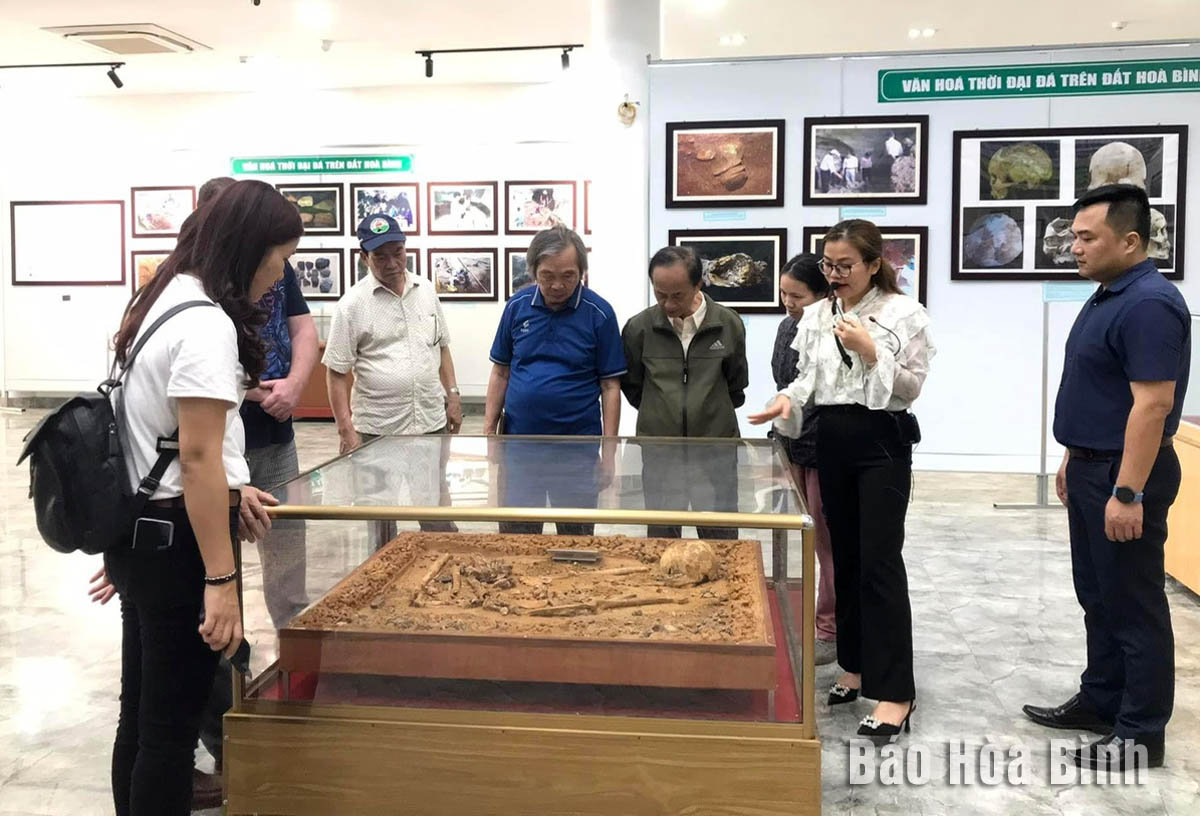
(HBO) – Hoa Binh Culture – a Stone Age culture dating from 18,000 - 7,000 years ago, was discovered by Madeleine Colani - a French female archaeologist in 1926. In 1932, the first conference of Far Eastern pre-historicists meeting in Hanoi recognised the term "Hoa Binh Culture”, named by Colani, as a term to refer to an ancient culture that appeared and existed on territory of prehistoric Vietnam.

Tourists
learn about Hoa Binh Culture artifacts at the provincial Museum.
The Hoa Binh Culture spread throughout
Southeast Asia, but most found relics of the period are concentrated in Hoa
Binh province with over 80 out of 150 relic sites found in Vietnam. The
archaeological sites belonging to "Hoa Binh culture” are mainly located in
clusters of caves or rock shelters. They have been discovered in Trai hamlet’s
cave in Tan Lao district, Vanh hamlet’s rock shelter in Lac Son district, Cho
cave in Luong Son district, Dong Thot cave in Lac Thuy district and Muoi cave
in Tan Lac district.
Over the past years, the work of preserving
and promoting the value of Hoa Binh Culture has received attention from Party
Committees and authorities at all levels. Many archaeological relic sites of
Hoa Binh Culture in the province have been ranked at the national level.
In 2022, the provincial Department of
Culture, Sports and Tourism and the provincial Museum coordinated with the
Institute of Archaeology, the Vietnam Academy of Social Sciences, and Centre
for Southeast Asian Prehistory to conduct archaeological excavations at
national relic sites: Vanh hamlet’s rock shelter and Trai hamlet cave. These
are two typical archaeological relics of Hoa Binh Cultural in the province in
particular and Vietnam in general.
With unique archaeological cultural values
of a world-famous Stone Age culture in Hoa Binh, local authorities are making
scientific documents asking for competent agencies’ recognition of the two
relic sites as special national historical relic sites.
Hoa Binh province has carried out multiple programmes and initiatives to revive its cultural heritage which has gradually fallen into oblivion through the ebbs and flows of history.
The most prominent and defining feature in the prehistoric era of Hoa Binh is the Hoa Binh Culture. The Culture was first discovered in Hoa Binh. The significant prehistoric culture represents not only Vietnam but also Southeast Asia and southern China. Through excavations of cave sites in the limestone regions of Hoa Binh, French archaeologist M. Colani introduced the world to a "Stone Age in Hoa Binh province – Northern Vietnam" in 1927. On January 30, 1932, the First Congress of Far Eastern Prehistorians, held in Hanoi, officially recognised the Hoa Binh Culture.
Known as the "Land of Epic History”, Hoa Binh province, the gateway to Vietnam’s northwest, boasts a strategic location and a unique cultural tapestry woven by its ethnic minority communities.
The People's Committee of Luong Son District recently held a ceremony to receive the certificate recognizing Sau Communal House in Thanh Cao Commune as a provincial-level historical and cultural site.
Recognising the importance of cultural heritage preservation in protecting and promoting the value system of Vietnamese culture, and serving socio-economic development in the new period, Party committees and local administrations in Hoa Binh province have identified it as a key task in the cultural development strategy. The province has been making efforts in mobilising resources, creating consensus among people and engaging ethnic communities in preserving and promoting cultural identity.
Hoa Binh province has captured growing attention both domestically and internationally for its distinctive cultural heritage and rich history. Most notably, it has been renowned for its famous Hoa Binh culture, considered the cradle of ancient Vietnamese civilisation. Looking ahead to significant milestones in 2025 and the 140th anniversary of province establishment in 2026, Hoa Binh Newspaper presents a comprehensive overview of the province's development across economic, social, cultural, tourism, and security domains.



